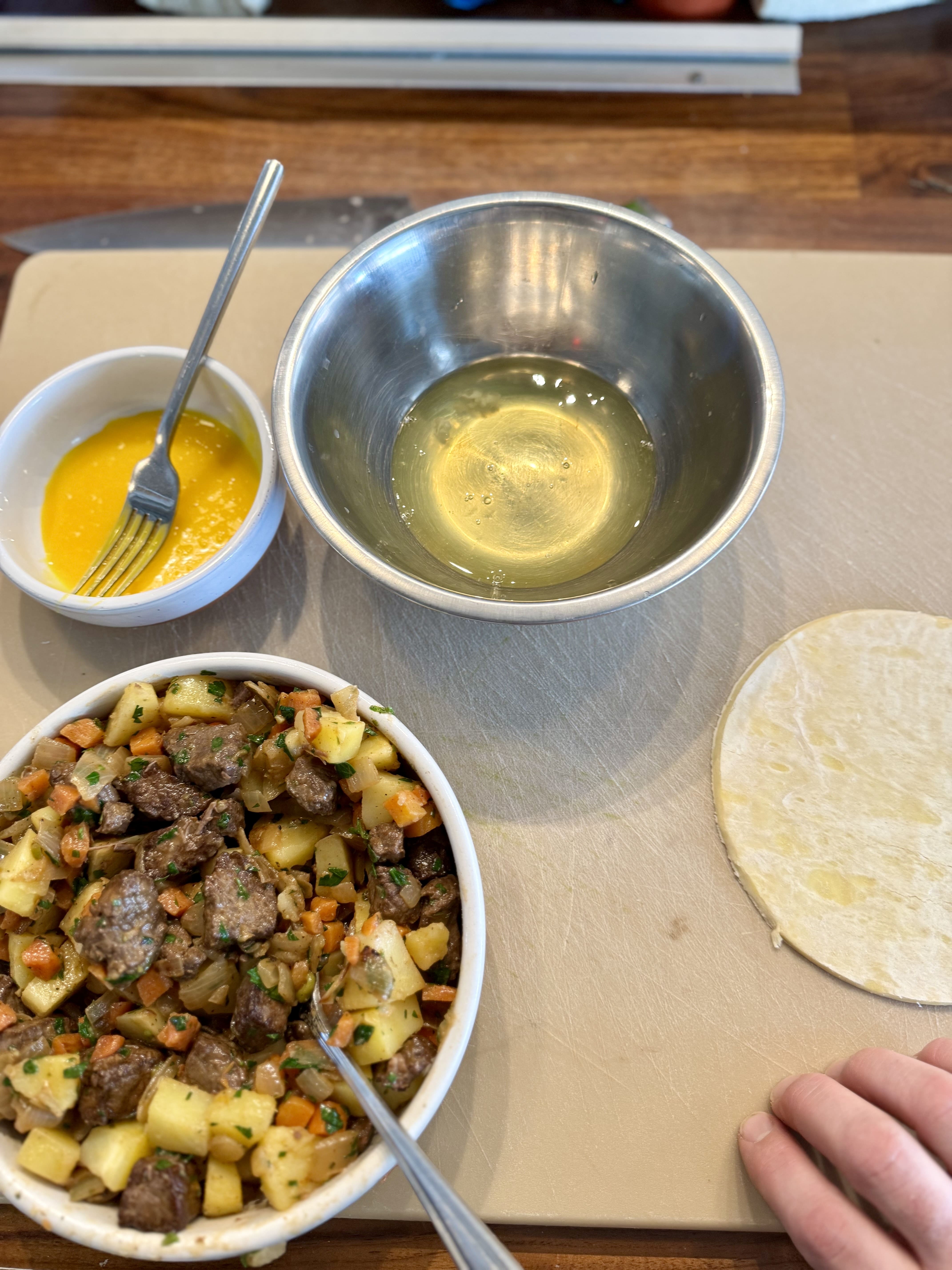Montana Pasties
 | Author:
Jon Bennion, Montana Free Press
Jon Bennion, Montana Free Press |
Montana Pasties
This article by Jon Bennion was originally published in the Montana Free Press on February
25, 2025 and is published here courtesy of the Montana Free Press.
https://montanafreepress.org/2025/02/24/building-a-tastier-pasty/?utm_medium=email
If you’re a longtime Montana resident, there’s a good chance you’ve consumed a pasty or two. And the closer you reside to Butte or Anaconda, that number will go up exponentially.
These original hot pockets, brought to America by Cornish immigrants (that’s right, they’re not Irish), have a special place in the hearts of many in Big Sky County, including me. Today I’m sharing a recipe that transforms this humble dish into something that could easily take its place on a fine-dining menu. In fact, this recipe is brought to you by the culinary experts at The Union restaurant in Helena, which was recently nominated for a James Beard Award.
I know that “upgrades” to beloved and iconic dishes can be controversial, and that the pinnacle of pasty perfection is usually the version your grandma made. Her recipe was undoubtedly a homemade pastry crust with a filling of beef, potatoes and onions spiced with salt and pepper. There’s no sauce on the inside — that would make it a pot pie, not a pasty.
Those elements are universal in every pasty I’ve ever consumed. This style was simple to assemble and cheaply made with easily sourced ingredients to become fuel for miners who needed a hearty meal in the underground copper mines of Butte. The melting pot residents of Butte and Anaconda, Cornish and otherwise, all embraced the pasty, and it lives on in many shops and menus around the state.
When you look at original recipes from Cornwall, instructions and how-to articles dating back 100 years in Butte, and the modern-day variations I’ve come across, you have to admit that the pasty your grandma made may not have been the norm, even if it is tasty.
First, let’s talk about that pastry crust. The fat used to pair with the flour can be butter, lard, shortening, or a combination. Lard is less frequently cited in modern recipes, but it’s an absolutely delicious option. In some versions, baking powder is suggested as a leavener to make the pastry a bit lighter. This recipe uses ready-made puff pastry to let you focus more on the filling.
The ever-present beef in pasties can be either ground or cubed. Recommended cuts of beef for the cubed route are all over the map, depending on the texture and flavor you’re going for.
The non-meat elements of the filling aren’t always as simple as potatoes and onions. Older recipes often included much more, depending on what ingredients were available locally and how complete a meal the pasty was intended to be. Many versions from Cornwall added rutabaga to the potatoes-and-onions mix, which can add a yellow color and a bit of cabbage-like flavor. Several old versions I’ve seen from Butte included carrots. Dried or fresh herbs could also be used to elevate flavors and make them more complex. In an effort to pack more flavor and color into an offering that can sometimes border on bland, the version I present here has many additions that bring the pasty into gourmet territory.
Finally, the condiment question can be an especially polarizing aspect of the pasty discussion. The dry interior begs for some kind of sauce to dip or slather over the exterior to bring it all together. Pasty-packing miners likely didn’t have this option, but the debate among most pasty consumers is between ketchup and gravy. I happen to be firmly in camp gravy. The savoriness delivered by a nice helping of beef or onion gravy really can’t be matched by the cold, sweet, red stuff from a bottle. If ketchup is your jam, I won’t fight you, but don’t take my gravy.
Andrew Mace, culinary director at The Union, has come up with a recipe that your grandma almost certainly did not make, but assuredly would have devoured. As he queried colleagues and customers about their pasty preferences, Mace said he was shocked at how passionate people are about their choice of sauce, with ketchup being the top choice. He uses The Union’s house-made ranch dressing.
March 5 just happens to be St. Piran’s Day, memorializing the patron saint of Cornwall. That’s plenty enough reason to try some gourmet pasties that would make your grandma proud, and ensure your family and friends are well-fed.
Tap ’er light!
GRASS-FED BEEF PASTY RECIPE
From Andrew Mace, culinary director, The Union
(makes 4-6 pasties)
INGREDIENTS:
1 lb grass-fed local beef stew meat (3/4-inch diced)
1 qt beef broth
1 tbsp tomato paste
1/4 cup red wine
1 large local organic Yukon Gold potato (peeled and cubed)
1 large carrot (medium diced)
1 large onion (medium diced)
1 sprig rosemary, chopped
3 cloves garlic, minced
2 tbsp butter
1/4 cup chopped parsley
2 tbsp chopped chives
salt and pepper to taste
2 large eggs (separated into whites and yolks)
1 box puff pastry
all-purpose flour for dusting the puff pastry
3 tbsp avocado oil
You can use a variety of cuts of grass-fed beef for this recipe — brisket, chuck roast and shank all work well. Whatever cut you choose, start by dicing the beef into approximately 3/4-inch cubes. Season the meat with salt and pepper. In a medium-sized stock pot on medium-high heat, add 3 tbsp avocado oil. (Mace highly recommends seed oil-free cooking oils.) Once the oil is hot, carefully add the diced meat. Brown the meat over medium-high heat for about 6-7 minutes.
Add the tomato paste and caramelize for about 2-3 minutes. Deglaze with the red wine, cooking all the alcohol out for about 1 minute. Add the beef broth, lower the heat, and simmer for about 20-30 minutes until the beef is tender but not falling apart. Allow the meat to cool in any liquid that remains. If you like gravy with your pasty you can remove the meat and use the remaining liquid to make a quick gravy.
While the beef is simmering, peel the potatoes and cut into 1/4-inch cubes. Place the cubes in the pot and cover with cold salted water. Bring to a boil and then turn down to simmer until the potatoes are fork-tender. Once the potatoes are done, strain them out and set aside to cool.
In a medium-sized sauté pan, add 2 tbsp butter, then add the onions, carrots, garlic, chopped rosemary and salt and pepper. Cook on medium heat until the carrots are tender. Once all the meat and vegetables are cooked and cooled, mix them together with chopped parsley and fresh chopped chives, with a pinch of salt and pepper to taste.
Preheat your oven to 375 Fahrenheit. On a lightly floured surface, roll out the puff pastry until it is about 1/4 inch thick. Using a small plate or a 6-inch pastry cutter, cut large circles with a small knife. Place each circle onto a baking pan lined with parchment paper.
To assemble the pasty, take one circle of dough and lightly brush the outer edge with egg white. Place a large spoonful of filling in the center of the puff pastry circle. Carefully fold the pastry dough in half to make a half-moon shape. Press gently along the outer edges. Using a fork, press 1/2-inch crimp marks along the outer edge of the dough to make a tight seal. Brush the outside of the pasty with a thin layer of egg yolk and place back onto the parchment-lined baking pan. Repeat this process until all the pasties are assembled.
Bake in the preheated oven for about 20-25 minutes, until the pastry crust is golden brown and fully cooked. Serve with the sauce of your choice.
Article Images
Click on Image Thumbnail(s) to view fullsize image
PhotoCredit: Jon Bennion
Image 1 Caption: Montana Pasties
Image 2 Caption: Pasties ingredients

